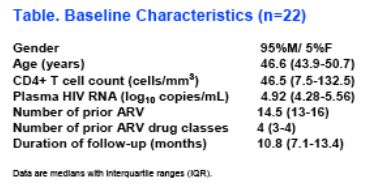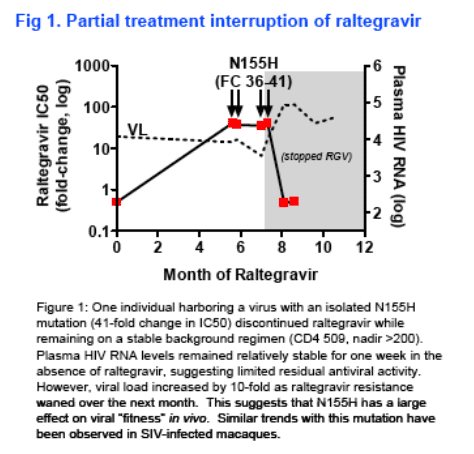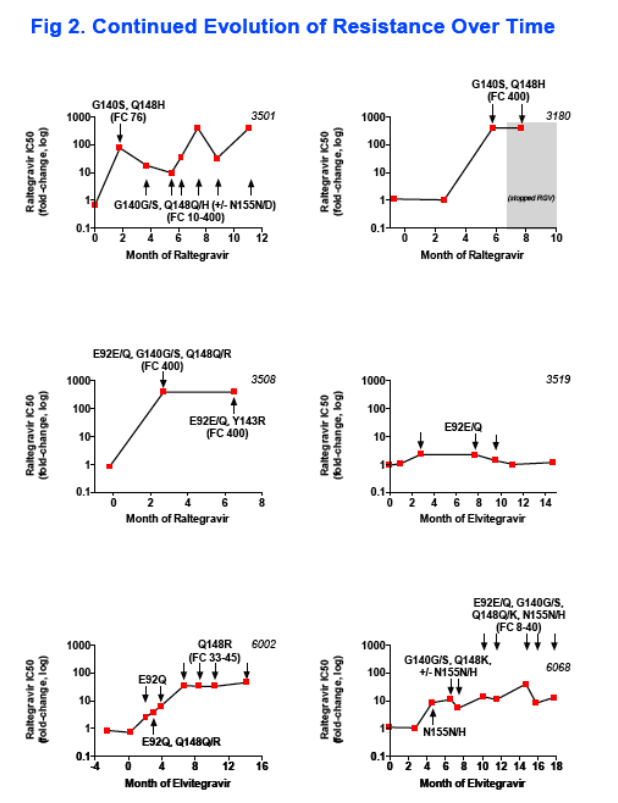 |
 |
 |
| |
Virologic and Immunologic Outcomes in a Cohort of Subjects Failing Integrase Inhibitors
|
| |
| |
Reported by Jules Levin
17th Intl HIV Drug Resistance Workshop
June 10-14, 2008
Sitges, Spain
Hiroyu Hatano1, Harry Lampiris1, Wei Huang2, Rebecca Hoh1, Soumi Gupta2, Signe Fransen2, Jeffrey N. Martin1, Chris Petropoulous2, and Steven G. Deeks1
1University of California, San Francisco, CA, USA; 2Monogram Biosciences, South San Francisco, CA, USA
Background
Although integrase inhibitors are highly effective in the management of drug-resistant HIV, some patients fail to achieve durable viral suppression. The long-term consequences of integrase inhibitor failure have not been well defined.
Methods
We identified 22 individuals who exhibited evidence of incomplete viral suppression on a regimen containing an integrase inhibitor (17 raltegravir, 5 elvitegravir). Genotypic and phenotypic resistance testing was performed at Monogram Biosciences.
Results
· Integrase inhibitor failure was often associated with the emergence of genotypic and phenotypic resistance, although 4 individuals with partial adherence lacked evidence of resistance despite long-term failure.
· The G140S and Q148H/K/R mutations were common and almost always occurred together. These mutations often emerged early and were associated with high-level phenotypic resistance (mean FC 141).
· The N155H mutation was less common (n=4). N155H was associated with lower levels of phenotypic resistance than G140S + Q148H/K/R.
· The Y143R/C mutation (n=3) occurred in the absence of G140S, Q148H/K/R, or N155H. It was associated with high-level resistance. Y143R tended to be observed after long-term failure.
· Despite evidence of integrase inhibitor failure subjects appeared to have a persistent immunological benefit, with a median change in CD4 T cell count of +42 and +50 cells/mm3 at month 3 and month 6 of documented failure, respectively.
· Howver, there was evidence of continued evolution of resistance over time in subjects who remained on a failing integrase inhibitor containing regimen.
"One individual harboring a virus with an isolated N155H mutation (41-fold change in IC50) discontinued raltegravir while remaining on a stable background regimen (CD4 509, nadir >200). Plasma HIV RNA levels remained relatively stable for one week in the absence of raltegravir, suggesting limted residual antiviral activity. However, viral load increased by 10-fold as raltegravir resistance waned over the next month. This suggests that N155H has a large effect on viral 'fitness' in vivo. Similar trends with this mutation have been observed in SIV-infected macaques".



Conclusions
Although experience from clinical trials suggests that the majority of patients receiving integrase inhibitors do well, there remains a subset of individuals for whom these drugs will not work because of pre-existing resistance or non-adherence.
In this cohort of treatment-experienced subjects failing an integrase inhibitor containing regimen, the G140S/Q148H pattern was the most common mutational pattern, but other patterns emerged with time.
Integrase genotype and phenotype resistance appears to evolve over 6-12 months of incomplete suppression.
Integrase inhibitors may provide a residual clinical benefit despite lack of complete viral suppression.
This benefit may be due in part to alterations in viral fitness, as suggested by changes after removal of raltegravir in a single individual.
In the program book, Hatano says "Notably, this latter observation is consistent with observations from the SIV-infected macaque model, where removal of integrase inhibitors in animals harboring the N155H mutation was associated with initial stable viremia followed by rapid increase in viremia as the mutations waned.
From Jules: this should be weighed against the potential for accumulations of mutations that might occur while continuing failing raltegrevir therapy, with detectable viral load. There was discussion of this subject, as I raised it at the meeting, a concern regarding leaving virologicaly failing patients on raltegravir. Several thought leaders I spoke with felt that if a very treatment-experienced patient had few or no options left that could achieve undetectable viral load and the patient had a low CD4 count, say 200, it might be better leaving the patient on a failing raltegravir regimen; Deeks reported he found viral load went up after the mutation disappeared after stopping raltegravir. The question that comes up is when the next generation integrase inhibitor will become available. If it takes 3-5 years, as expected, then removing a patient from raltegravir may not matter in terms of not accumulating mutations so the patient could respond to the next generation inhibitor. Because if they have no other options now they might not be alive anyway for the next generation integrase inhibitor. If however the patient has 350 or 500 CDs cells perhaps it might be better if you detect raltegravir resistance early and remove relategravir to avoid accumulation of mutations. An unanswered question is what mutations prevent the next generation integrase from responding. If a patient remains on raltegravir and accumulates certain mutations will the next generation Merck integrase inhibitor or another integrase inhibitor provide a response. I don't know the answer to that question, and we don't yet have data (resistance profile) from the next integrase inhibitor, in vitro or in vivo, to evaluate the question.
|
| |
|
 |
 |
|
|